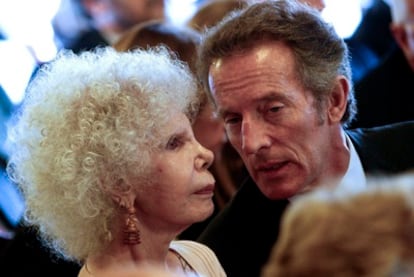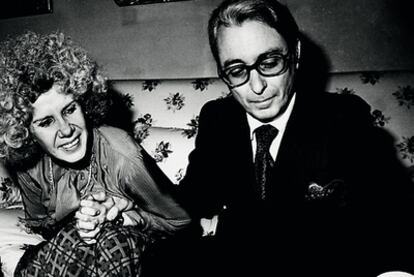The duchess marries for love
Cayetana Fitz-James Stuart has passed on her wealth to marry a man 25 years her junior
For the last three years, the pages of Spain's gossip magazines have been filled with will-she-won't-she tittle-tattle as to whether the country's grandest of grandees, the 85-year-old Duchess of Alba, Cayetana Fitz-James Stuart, would marry Alfonso Díez Carabantes, a civil servant and businessman almost 25 years her junior.
Since the death of her second husband 10 years ago, the duchess has enjoyed a close relationship with Díez Carabantes, an old family friend of some 30 years' standing. In 2008, it emerged that the duchess's plans for a secret marriage to him had been scotched at the last minute by her six children. They had long vetoed the match, and on that occasion reportedly enlisted the support of King Juan Carlos, who allegedly made a discreet phone call to the octogenarian Duchess, suggesting she hold off on the nuptials.
The duchess's plans for a secret marriage were scotched by her children
The duchess sought an audience with Queen Sofía to enlist her support
She is the most-titled person on earth, with nearly 200 to her name
The Spanish royal family has traditionally had a deciding voice in matters concerning the House of Alba, so the duchess sought an audience with Queen Sofía to enlist her support.
Some in the gossip business have insinuated that Díez is little more than a gigolo, portraying him as preying on a frail old woman alienated from her children and with a diminishing grasp on reality. Others have pointed out that Cayetana has always done as she pleases, and that it's a bit much if the world's most-titled aristocrat can't spend her twilight years with the man she loves.
So, to put an end to the speculation, last month Cayetana de Alba called her children to a meeting at a Madrid notary public's office. There, they were told that their mother had decided to hand over to them her enormous wealth; innumerable palaces, priceless works of art, and vast swathes of Spanish real estate, and to marry for love. By giving up her wealth before her death, it appears she has finally won her children's support: the wedding is planned for late September or early October. "They don't want me to marry, but they change partners more often than I do," the duchess has said about her six children, all of whom have had high-profile marriages that ended in divorce.
In short, even though Díez has signed a document renouncing any claim to her wealth, the duchess has decided that the best way to dispel any doubts is to divide her fortune between her offspring to convince them that her suitor is only interested in her, and not her money. "I still don't know why my children are causing problems," the duchess complained to Catholic Church-run radio station La Cope in February, adding: "We aren't hurting anyone. If only things could be fixed... Alfonso doesn't want anything - he's renounced everything. He doesn't want anything but me."
The duchess's fortune includes palaces and mansions throughout Spain - she will leave at least one to each child - and paintings by the likes of Velázquez, Goya and Rubens. She owns so much land in Spain that it is reputed she could travel from one end of the country to the other through her estates. Her wealth is estimated at between 600 million and 3.5 billion euros.
All her children were born to her first husband, engineer Luís Martínez de Irujo, son of the Duke of Sotomayor. In 1978, six years after he died, she shocked many in Spain by marrying an illegitimate defrocked Jesuit priest, Jesús Aguirre. Over the years there have been rumors of lovers from the worlds of bullfighting and flamenco.
But her most recent match has divided the House of Alba, and the quarrel has been played out in gossip magazines such as ¡Hola!. Her second-youngest child, Cayetano Martínez de Irujo, the Duke of Salvatierra, said recently that he had only met his mother's suitor three times, and that she shouldn't marry because of her "historic responsibility."
Martínez de Irujo will inherit the Arbaizenea Palace in San Sebastián, along with Las Arrroyuelas, one of the largest tracts of privately owned land in Seville province. Cayetano, aged 48, plays an active role in the family businesses, running farming enterprise Eurotécnica Agraria, which received 1.7 million euros in EU subsidies in 2009.
The family tradition is that Las Dueñas, the vast 16th-century palace in the heart of Seville's old quarter, is left to the child who will take over the house of Alba. That is why it has gone to Fernando Fitz-James Stuart y Solís.
Last year, the Andalusian regional government catalogued some 1,425 works among the palace's art collection, including pieces by Bassano, Luca Giordano, Sofinisba Anguisola, Annibale Carracci, Sorolla, Zuloaga, and Romero de Torres - none of which can leave Seville without authorization. The Duchess has also left land and property to each of her other eight grandchildren.
Carlos Fitz-James Stuart, the duchess's eldest son, will continue at the helm of the House of Alba Foundation, which includes the palaces of Liria, in Madrid, and Monterrey in Salamanca, and will also inherit around 50 titles and their corresponding estates, among them the huge tracts of land in Córdoba known as El Carpio. The 63-year-old Fitz-James Stuart has worked alongside his mother, managing the family's myriad investments and companies, among them Inversiones Princesa, Eurotécnica Agraria, Euroexplotaciones Agrarias, Agrotecsa, Agralsa, and Castrofresno.
Alfonso Martínez de Irujo, the Duke of Aliaga, the second-eldest son, is an economics graduate from Madrid's Complutense University, and also plays a key role in helping run the family businesses. Along with land throughout Spain, he has been left El Tejado, a 14th-century castle in Calzada de Don Diego in Salamanca.
Jacobo Fitz-James Stuart, the Count of Siruela, the founder and head of publishers Siruela, will also inherit large tracts of land.
Fernando Martínez de Irujo, the Marquis of San Vicente del Barco, is in banking, and will be taking over Las Cañas, a large property in Marbella.
Eugenia Martínez de Irujo, the Duchess of Montoro, the youngest of the family, will take over Sa Aufabaguera, the family's vacation home in Ibiza. She will also inherit La Pizana, a 600-hectare estate outside Seville given to her by her mother when she married bullfighter Francisco Rivera Ordóñez, whom she later divorced.
Most of the duchess's property belongs to the House of Alba Foundation, set up in 1975. This runs the Liria and Monterrery palaces, along with the family seat in Alba de Tormes, and four country homes in Galicia. The foundation also owns four shops in central Madrid.
Among the foundation's treasures is a collection of historical documents that include Columbus' first map of the Americas and the last will and testament of Fernando the Catholic, as well as a library valued at 20.5 million euros that includes a first edition of Don Quixote from 1605, and a family Bible from 1429. In reality, as with Las Dueñas in Seville, the family could not sell any of these treasures without the permission of the Culture Ministry: they belong to the foundation. The collection is further protected by legislation governing their historical status.
The Duchess of Alba was born in the Liria Palace in Madrid, which houses Goya's full-length portrait of her ancestor, reputed to have been his lover and model for his masterworks, The Clothed Maja and The Naked Maja. She is a descendant of King James VII of Scotland through his illegitimate son James Fitz-James, Duke of Berwick (1670-1734), born of a relationship with Arabella Churchill, the only sister of the Duke of Marlborough, making her a distant relative of both Sir Winston Churchill and Diana, Princess of Wales.
A dazzling beauty in her youth - she has since undergone extensive plastic surgery that has left her almost unrecognizable - possessor of 44 noble titles and 150 hereditary ones, the duchess is renowned for her forthright character, forged during a high-rolling spell in England in the Second World War where her father, the 17th Duke, was Spanish ambassador in London.
In 1947 She married Luis Martínez de Irujo y Artacoz, son of the Duke of Sotomayor, in what The New York Times dubbed "the most expensive wedding in the world". The couple lived mostly in Las Dueñas, where they brought up their six children. She is said to have enjoyed a lively love life. The father of her fourth son, Fernando, is widely reported not to have been her husband but the flamenco dancer known as Antonio.
Her children are said to be divided over their mother's marriage plans. Carlos, Alfonso and Cayetano are said to oppose the match, while Jacobo, Fernando and Eugenia want their mother to be happy.
In recent years there have been reports that the duchess's health is failing, and there have been a number of scares. She was famously photographed in a wheelchair attending the wedding of her grandson Javier Martinez de Irujo Hohenloh to Inés Domecq, heiress to the sherry dynasty, in Jerez in 2008.
After the reception she is said to have choked on orange juice. Pulmonary, later cardiac, complications set in and a doctor reportedly had to save her life.
But days later, the duchess was snapped emerging from a restaurant to tell the press she was fine, fuelling speculation that she might have won the Queen's support for her marriage.
According to Guinness World Records, María del Rosario Cayetana Alfonsa Victoria Eugenia Francisca Fitz-James Stuart y de Silva has more titles than any noble on earth, being a duchess seven times over, a countess 22 times and a marquesa 24.
As head of the 539-year-old House of Alba, her droits de seigneur include not having to kneel before the pope and the right to ride on horseback into Seville cathedral.
But in the end, for all the pageantry and privilege, it seems that the duchess has had to yield to her children for the right to enjoy her final years with the man she loves.


Tu suscripción se está usando en otro dispositivo
¿Quieres añadir otro usuario a tu suscripción?
Si continúas leyendo en este dispositivo, no se podrá leer en el otro.
FlechaTu suscripción se está usando en otro dispositivo y solo puedes acceder a EL PAÍS desde un dispositivo a la vez.
Si quieres compartir tu cuenta, cambia tu suscripción a la modalidad Premium, así podrás añadir otro usuario. Cada uno accederá con su propia cuenta de email, lo que os permitirá personalizar vuestra experiencia en EL PAÍS.
¿Tienes una suscripción de empresa? Accede aquí para contratar más cuentas.
En el caso de no saber quién está usando tu cuenta, te recomendamos cambiar tu contraseña aquí.
Si decides continuar compartiendo tu cuenta, este mensaje se mostrará en tu dispositivo y en el de la otra persona que está usando tu cuenta de forma indefinida, afectando a tu experiencia de lectura. Puedes consultar aquí los términos y condiciones de la suscripción digital.
Últimas noticias
The complicated life of Francesca Albanese: A rising figure in Italy but barred from every bank by Trump’s sanctions
How Japan is trying to avert ‘digital defeat’
Half of Scotland is in the hands of 420 property owners
Reinhard Genzel, Nobel laureate in physics: ‘One-minute videos will never give you the truth’
Most viewed
- Pablo Escobar’s hippos: A serious environmental problem, 40 years on
- Why we lost the habit of sleeping in two segments and how that changed our sense of time
- Charles Dubouloz, mountaineering star, retires at 36 with a farewell tour inspired by Walter Bonatti
- Reinhard Genzel, Nobel laureate in physics: ‘One-minute videos will never give you the truth’
- The Florida Keys tourist paradise is besieged by immigration agents: ‘We’ve never seen anything like this’








































